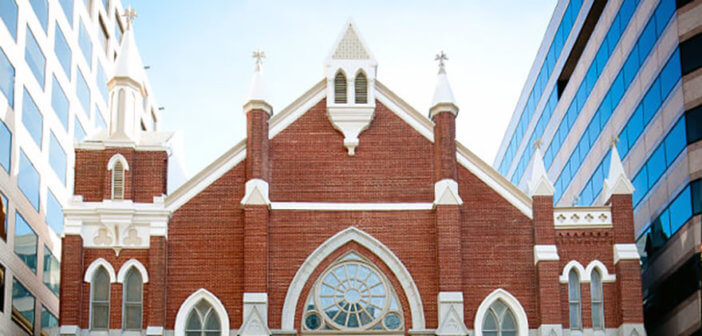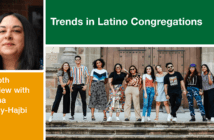Rev. William H. Lamar IV, pastor of the historic Metropolitan African Methodist Episcopal church in downtown Washington, DC, considers what it means for an older urban church to thrive in a changing context while remaining committed to its history and values.
Many church leaders today are asking “What are we to do?” and “How are we to do the things we are called to do?” But to me, the preeminent question is not “What?” or “How?” but rather “Where?” “Where has God sent you?” It is for us to tend to the spaces where we have been called.
My forebearers worked the land. They knew that the soil was rich. The soil was precious. And it produced fruit that could not be produced in other places. In any place, you have to know the soil — the people, the resources, the struggles, the joys. You have to invest time to learn the history of your space and the story of your congregants and community members.
On holy ground
When people come into Metropolitan AME’s sanctuary, the scripture that comes to mind is Moses being instructed to take off his sandals because he is standing on holy ground. Our church is the longest continuously owned property by African Americans in the District of Columbia. The people who dreamed of Metropolitan had a huge view of who their God was. They had a huge view of their potential and the potential of their progeny. The massive sanctuary was built with the support of annual conferences across our connection who sent dimes and dollars that came from the pockets and coffee tins and from beneath the mattresses of women and men who had been enslaved. They bequeathed the space to us.
To those who pass by our church today, it appears to be out of time and place, surrounded by towering office buildings in a part of Washington where property values rank among the highest in the world. But in the 19th century, this neighborhood was filled with tenement buildings, apartment houses, people walking, people hanging their clothes out to dry. Although many people now come a longer distance to be with us, there is a recalcitrance and a stubbornness to us. We will not leave because our mission is not fulfilled in this city. Our God has not left this city. And our witness may well be more necessary than it was when we were founded. Metropolitan AME was founded, in the midst of a culture that assailed and assaulted, as an ark of safety for anyone who believed in human equality, God’s justice, and that we are ultimately one family. And there hasn’t been a time in recent memory when that message is more needed than it is now.
What are we committed to?
People here would surrender all that we are for this space — not because we invest divinity in the brick and mortar, not because the building is an idol to us — but because the idea, the God, and the people who made this possible are worth living and dying for. The people in this church have been generous enough to allow us to stay and do the work that we need to do. If that were not the case, we would be dealing with a different set of questions — as many churches must. But now the question we ask is, “How do we preserve into the future this space and the ministry it is known for?”
As a practical reality, churches in urban spaces must ask, “Who are we and what are we committed to?” Maintaining a building built in the 1880’s is very costly. You can’t be unclear about your purpose in a place where every dollar is very valuable and every amount of time that you have together is very valuable. Based on our history, our prayer, and our engagement with God’s spirit, we have determined that Metropolitan is about worship, liberation, and service. First, we exist to worship and extol the one who made us. And from that space of worship, we are moved to liberation — to want to be free and then free others. And finally, once we have worshiped and been liberated and been liberating to others, then we serve others.
In doing that work, we have been surprised at how resources and people come to us. We don’t have a huge marketing machine. But when we show up for the people that God wants us to be in relationships with, and fight with and for them, people come to us. Churches in urban spaces that feel their strength slipping must ask, “Are we living for ourselves or our community?” Churches who prioritize the needs of the community will reap the support and regard of the community.
Salvation in the city
In the Bible, creation begins in a garden, but it culminates in a city, what John on Patmos calls the New Jerusalem. While God has a fondness for people in all spaces, there is something sacred about the metaphor of the city — where people of all races, backgrounds, creeds, tongues, meet, gather, share food, share ideas, make families. It is a glimpse of the universality of God’s salvation, of God’s love and God’s reach.
When I imagine this church in another 10 or 20 years, I envision it overflowing with people and energy, because for almost two centuries, we will have proven a commitment to this city and to the God of the universe. I imagine it lifting up Jesus by caring for those Jesus cares for; risking life, reputation, prestige, as Jesus did; telling uncomfortable truths in religious spaces and in political spaces, as he did. This vision springs not from Pollyanna-ish optimism, but from a serious commitment to Christian hope — what it means for the reign of God to be breaking into this time and space. I can literally see God dancing in this place and dancing in this city, calling us to dance with God and do the work of building beloved community.
Related Resources
- “Rooted in Place — Committed to the City,” a Leading Ideas Talks podcast episode featuring Bill Lamar
- 5 Key Practices for Connecting with Your Context by Mark Gornik and Maria Liu Wong
- Your Community is Your Congregation by Joe Daniels







